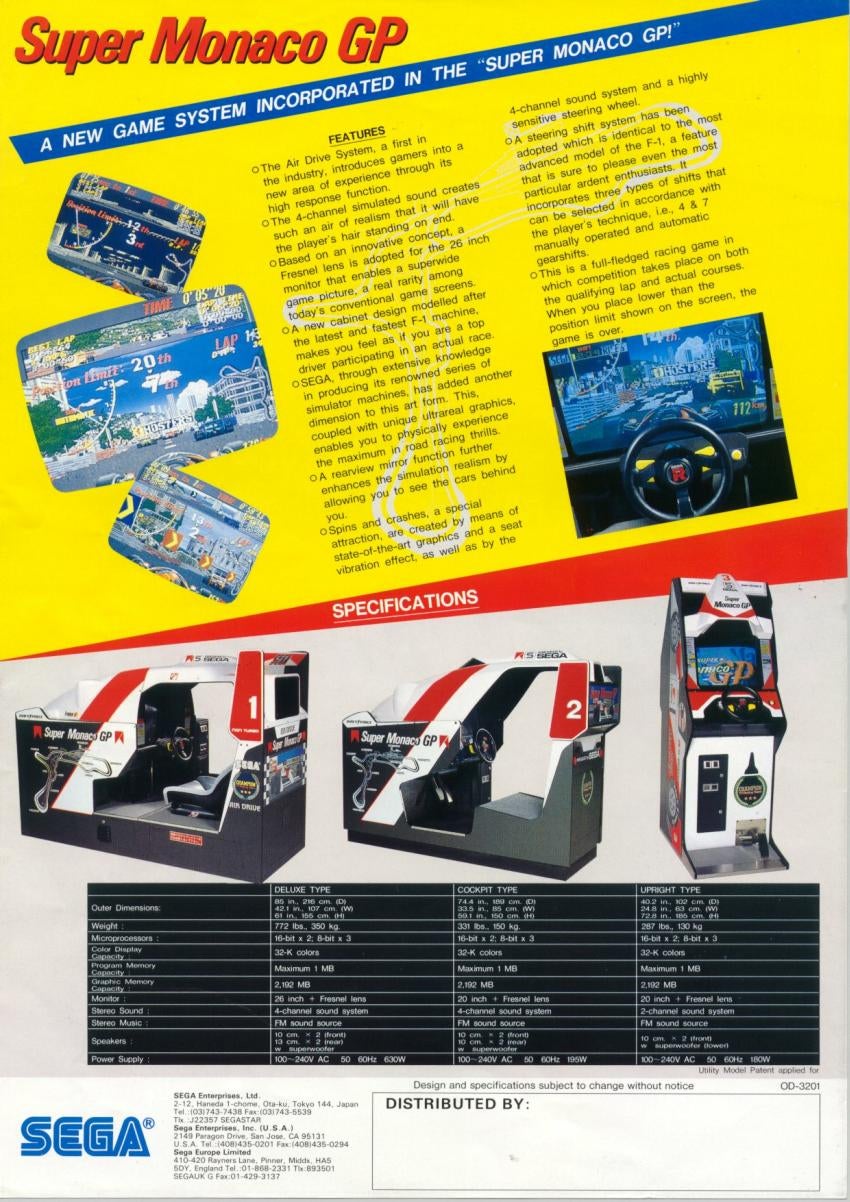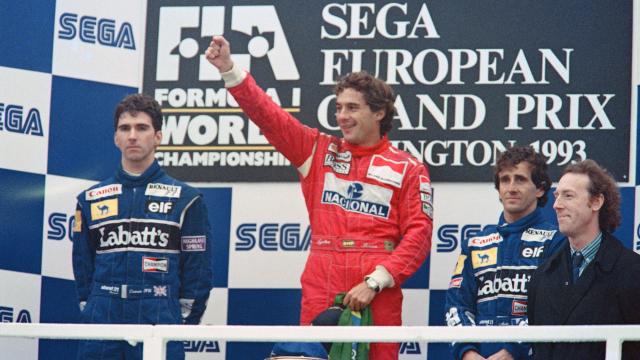Up until middle school, all the kids in my hometown had their birthday parties at the same roller rink. That roller rink contained a small arcade with games that seemed hopelessly outdated to us at the time but would rake in quarters at any Barcade now. Stuff like X-Men, Ivan Stewart’s Super Off Road and Killer Instinct.
In the corner of the room was a semi-enclosed cabinet painted in white and red with Marlboro-like logos on it, because you could get away with tobacco iconography on a game for children in the ’90s. None of us approached this machine because we didn’t understand it. It was big, confusing and dark inside. You crawled into it, and your eyes were instantly overwhelmed with dithered, grainy 2D sprites flying toward you faster than you could ever react. This was Sega’s Super Monaco GP.

The original Super Monaco GP is a really beautiful game, in that it arrived at the peak of Sega’s sprite-scaling supremacy. Before the days when 3D polygonal games were possible, Sega mastered the art of layering, rotating and scaling a high quantity of 2D graphics with such speed that it created the illusion of perspective. Think Out Run, but with an even more dizzying barrage of visual information. Super Monaco GP also had that eye-catching cabinet, styled to look like a McLaren Formula 1 chassis from the time.
Sega eventually brought Super Monaco GP home to consoles like the Genesis/Mega Drive and Master System, though of course, these ports were incapable of replicating the spectacle of the arcade edition. The home releases were nevertheless successful enough to spawn a sequel — this time buoyed by an endorsement from the sport’s biggest name.
I always wondered how Sega landed Ayrton Senna, of all drivers, to partner with it on Super Monaco GP II. Sega had inked deals with athletes before, of course — Joe Montana Football and Tommy Lasorda Baseball being prime examples — but, as a racing fan, the Senna name carries incomparable weight.
As it turns out, Tectoy, a Brazilian importer of Sega products, asked Sega if it’d consider working with the then two-time champion. Senna was a star all over the world of course, but especially in Japan, so Sega didn’t need much convincing. However, rather than merely plastering his name and face on the box art as it had done with so many other athletes, Senna actively cooperated with Sega to improve the driving simulation.
The driver reportedly explained to the programmers how an F1 car should react over curbs, and offered feedback on the sense of speed. Players would receive tips written by Senna himself before visiting famous tracks, like Spa-Francorchamps and Hockenheim, and were able to drive three fictional circuit designs he contributed to the game.
Called Ayrton Senna’s Super Monaco GP II, the title released in 1992; appropriately, Senna is listed as a supervisor in the credits. (In a very strange coincidence, the following year Sega gained a new executive who would later lead the company, named Shoichiro Irimajiri. Irimajiri’s name will be familiar to any fan of two- or four-wheel Hondas — he designed the CBX as well as engines for Honda’s Formula 1 and Grand Prix motorcycle racing programs in the ’60s and ’70s.)
Senna’s input went beyond the examples above. For the full story, I implore you to check out this well-sourced article from Sega-16 that details every step of Senna and Sega’s partnership during Super Monaco GP II’s development. Supposedly, the man couldn’t enter or exit the company’s Tokyo headquarters without being accosted by adoring fans, which seems about right.
Nearly a year after Super Monaco GP II’s release, Senna went on to deliver one of the best performances of his career in the infamously rain-stricken 1993 European Grand Prix at Donington, passing his way from fifth to first within the first lap. Sega happened to be the title sponsor for this race, as if you couldn’t tell by the copious white-and-blue billboards encircling the track. Sega was also one of Williams’ main sponsors that year, reflected in a cute nod to Sonic the Hedgehog on the sides of the footwells of Alain Prost and Damon Hill’s cars.
Senna won the Donington race and was awarded two trophies on the podium. One was a Sonic statue, and the image of him hoisting it overhead (sadly, I can’t post it here) for me encapsulates everything wonderful about the ’90s in one photo.
A year later, Senna was gone. But he’d get one more Sega release bearing his namesake, exclusively sold in Japan in 1995 for the Saturn console. Called Ayrton Senna Personal Talk: Message for the Future, this is less a game and more just a disc of English-language interviews, preserved only in audio form, while still images of Senna flash above with Japanese subtitles overlaid.
The interviews themselves span 1987 to 1993, and some are so overrun with static that it’s difficult to make out the dialogue at times. It’s a strange and surreal release by today’s standards, though totally fitting for optical media at the time, and speaks to Japan’s admiration for the legendary driver. The disc includes three hours of interviews in total, where Senna speaks on a wide range of topics — from racing to spirituality, to how he stays motivated. At one point, he even theorizes as to how Brazil and Japan could learn from each other politically and socially.
I suppose it’s no surprise Sega and Senna worked together; this was the era of celebrity endorsements after all, and it was only a matter of time before some gaming giant corralled international motorsport’s biggest figure. Still, to young racing fans who grew up watching Senna demonstrate his brilliance every Sunday and also gamed on Sega hardware, the pairing of the two couldn’t have been more fitting. Today, almost 30 years later, the work they created together stands as a memento of a golden age of gaming and motorsport alike.

Comments